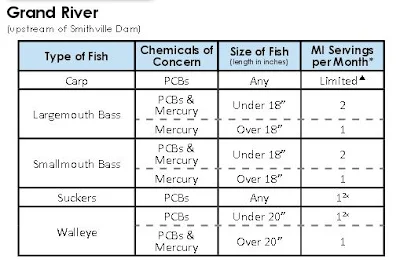I asked Mrs ERJ if she would consider cooking and eating wild-caught fish that I might bring home. She, in turn, asked me to look into contamination issues.
The State of Michigan publishes a Guidebook in an attempt to address those concerns.
It is pretty well put together. It defines portion size in a realistic and usable manner.
 |
| These portion sizes are generous compared to what you see in most dieting books but I think they are very realistic when you look at the amounts that people actually put on their plates. |
and it provides defaults to keep it manageable
The higher up the food chain the fewer servings you should eat per month.
One way to sort it out is that if you usually catch your fish with worms on a #8 hook, then you can eat eight servings a month. If you catch them with small minnows on a #6 hook they you are limited to six servings a month.
Carp are an exception because they vacuum up everything in the path, live a long time and get huge. You are allowed fewer servings of carp. This does not square with how Europeans eat carp. They turn up their noses at any carp that are larger than 2.2 pounds as not edible.
 |
| Here are one of the recommendations specific to Eaton county. You can see that Carp are not recommended and that the limit for Suckers is one quarter of the default. |
The guide also lists major bodies of water for each county. Some bodies of water, like the Kalamazoo river, are DO NOT EAT due to various types of contamination. Other watersheds are broken down by stretches based on historical risk of contamination and varying test results.




Interesting. We have some of the same fish. For example, you're pumpkinseed, we call a blue-gill, or bream. Your white crappie, we call white perch, or sac-a-lait. Small mouth bass, of course. Your white bass look a lot like our striped bass.
ReplyDeleteI don't know that anyone here ever worried about contamination.
For the most part, you are a pretty good fisherman if you can feed your family more than two meals a week of bream or shellcrackers. The action is in the bigger fish like catfish, carp, buffalo and such. These fish have a larger loading of contaminants and they can be caught by the hundreds of pounds.
DeleteLouisiana does have a fish advisory (http://www.deq.louisiana.gov/portal/Portals/0/planning/Advisories/Fish%20Consumption%20Advisory%20Table%20-%208-12-15%20-%20with%20subsegments.pdf)
Fish from the Catahoula basin (which I believe is close to your Parish) do have an advisory note:
Women of childbearing age and
children less than seven years of age
SHOULD NOT CONSUME
largemouth bass, white bass,
freshwater drum, flathead catfish, or
bowfin
(choupique, grinnel)
and should
consume no more than TWO MEALS
PER MONTH of white crappie from
the advisory area.
Other adults and children seven years
of age and older should consume no
more than TWO MEALS PER MONTH
of largemouth bass, white bass,
freshwater drum, flathead catfish, or
bowfin
(choupique, grinnel)
and should
consume no more than FOU
R MEALS
PER MONTH of white crappie from
the advisory area